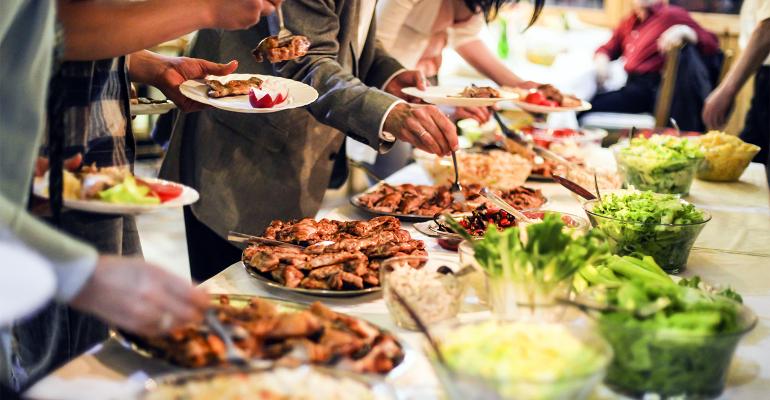Sponsored by Whirley-DrinkWorks!
Catering is a substantial revenue opportunity for operators today. However, building a successful catering program requires new skills, capabilities and a good deal of time and patience.
Those were among the conclusions reached by leading foodservice industry executives at a Beverage Roundtable during the NRA Show in Chicago in May. The sponsor of the roundtable was Whirley-DrinkWorks!, a designer and manufacturer of custom LTO drinkware, cause marketing programs and off-premise drink bag solutions.
“Catering needs to be incubated,” says Brian Farris, vice president of operations at Austin, Texas-based Schlotzsky’s. “It needs to be protected. It needs a big budget to get started because you are going to spend a lot of money in the beginning.”
Catering challenges
Catering, Farris adds, “is going to challenge everything you think you knew about the restaurant business because you’re now doing all kinds of crazy things. You’re outside selling; you’ve got the CRM [customer relationship management] part; you’ve got all kinds of things going on.”
Roundtable participants agreed that because catering differs so much from standard operations, the position of catering director in a restaurant company must be closely linked to top management. “Get it as high as possible in the organizational chart; get it reporting to the highest person possible — then you’re going to have success,” says Farris.
Ed Keller, director of off-premise business development at Dallas-based Corner Bakery Cafe, concurs. “When [catering] is new, you need someone to understand at a high level that it’s a slow build, that you’ve got to hit that sweet spot of orders per day before you figure out how to staff the restaurant properly. So you need buy-in at the highest level.”
Patience required
Patience is another essential trait for catering success, another roundtable participant says. “I think it’s very difficult when you first start,” observes Gracie Prasanson, director of sales at Beaumont, Texas-based Jason’s Deli. “You’re not going to open the front door and have all the catering you can handle. It definitely takes a lot of money upfront and time and effort to build.”
The up-and-down nature of a new catering business can be frustrating for operators minding their payroll. “Why am I having these people in the store today and I don’t have an order,” says Prasanson. The tendency is to reduce staff, but then a large order may arrive unexpectedly “and that stresses everybody.”
One of the additional benefits of catering is the way it introduces a restaurant brand to new guests. “The folks you’re delivering to a lot of times never enter your establishment,” says Prasanson. But it is a reasonable expectation that patrons who are pleased with a catering order may want to visit the restaurant to try the dine-in experience, too.
Expert sales team
There was consensus on the panel that a dedicated sales team is vital for driving awareness of catering. “They’re the ones out there building a relationship,” says Jackie Kurkjian, senior director, off premise, at Fiesta Restaurant Group, the Dallas-based parent of the Taco Cabana and Pollo Tropical fast-casual restaurant brands. “The operators at the restaurant level don’t have time to build those relationships as deep as they need to be.”
At Dickey’s Barbecue Restaurants, having a dedicated catering expert personally guide customers with their orders has been a boon to long-term business, reports Laura Rea Dickey, chief executive of the Dallas-based chain. That’s true even though consumers have become comfortable ordering as much as $300 of catering online — “a huge jump in the past two years,” she says.
But above the $300 threshold, they still want human interaction. “That’s been really important for maintaining long-term customers,” Dickey says.
Even in the digital age the telephone remains a useful tool. Keller says that a pre-delivery confirmation call by Corner Bakery staff puts catering customers at ease and avoids delivery delays that might result from unforeseen construction or building security. At Fiesta Restaurant Group eateries, personnel phone customers prior to a catering job to confirm the order and delivery instructions and take one more crack at selling. “Maybe they forgot to order beverages, so it’s an opportunity to upsell,” says Kurkjian.
Brands with a substantial catering business in several stores may find greater efficiencies by consolidating that into a single dedicated location. “We’re looking at catering hubs in markets that have high catering volume,” says Brianna Schmaltz, formerly senior director of catering at Coffee & Bagel Brands. [Editor’s note: Schmaltz has joined Red Robin since this roundtable took place.] “These locations are up against a capacity challenge because our stores were not initially designed to produce large amounts of off-premise business.”
With no end in sight to the craving for convenient food and beverages, building a successful catering program promises major rewards for operators. An example is Corner Bakery, where catering alone accounts for 25 percent of business, according to Keller. “We average $2.2 million annually in total sales per location, so that’s some significant sales,” he says.




